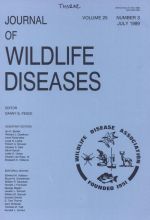The abundance of parasites of public health significance in pen-reared salmon and wild-caught salmon was compared. Two hundred eighty-seven salmon from Puget Sound, Washington, were examined for third-stage larvae of Anisakis simplex. Of these fish, 237 Atlantic salmon (Salmo salar), coho salmon (Oncorhynchus kisutch) and chinook salmon (O. tshawytscha) were reared in commercial salmon pens and 50 sockeye salmon (O. nerka) were caught during their spawning migration. All wild-caught salmon were found to be infected with larval A. simplex, conversely, all pen-reared fishes lacked such infections. Edible musculature of wild salmon were infected with 581 (87%) nematode larvae. Of other salmon parasites known to infect humans, one Diphyllobothrium sp. plerocercoid was collected from each of three of the 50 wild-caught salmon. The study showed that farmed salmon may increase the margin of safety for consumers of raw seafood.
How to translate text using browser tools
1 July 1989
Prevalence of Larval Anisakis simplex in Pen-reared and Wild-caught Salmon (Salmonidae) from Puget Sound, Washington
Thomas L. Deardorff,
Michael L. Kent

Journal of Wildlife Diseases
Vol. 25 • No. 3
July 1989
Vol. 25 • No. 3
July 1989
Anisakis simplex larvae
aquaculture
Diphyllobothrium sp. plerocercoid
intensity
Oncorhynchus spp.
parasites
pen-reared




